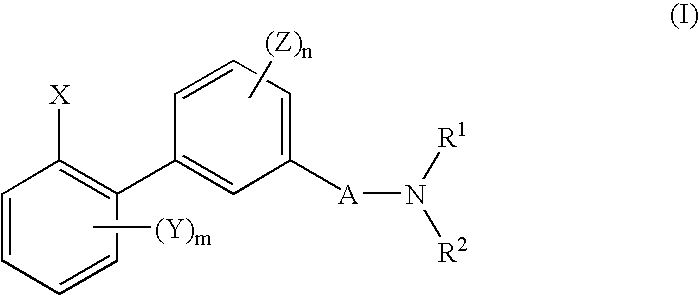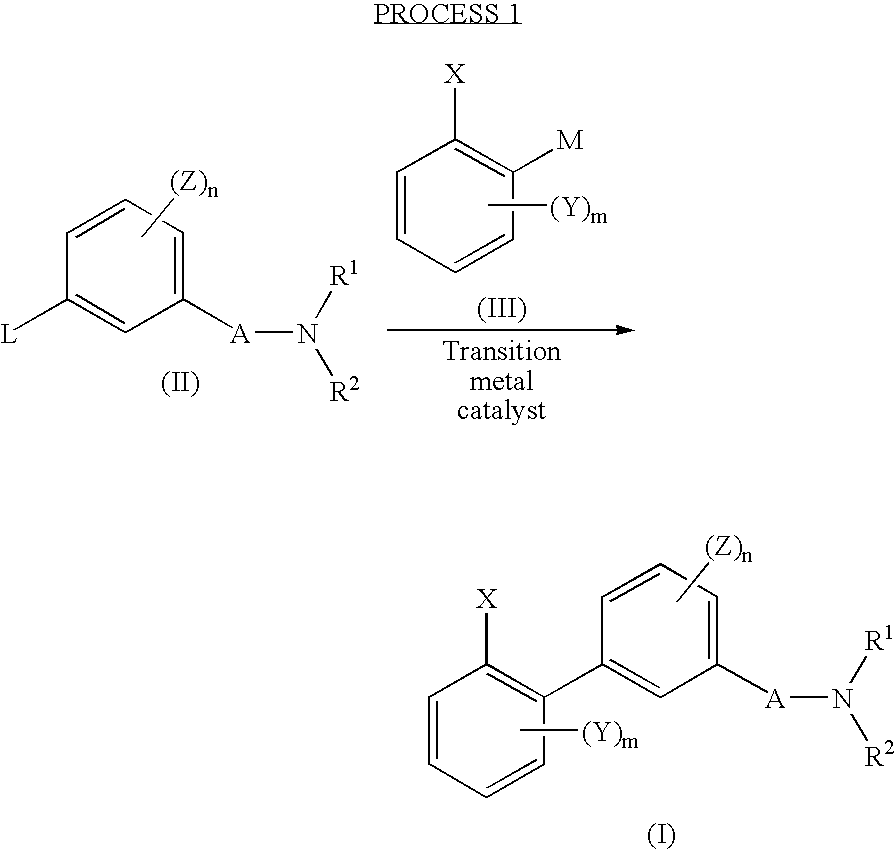Biphenyl derivative or its salt, and pesticide containing it as an active ingredient
a technology of biphenyl derivatives and active ingredients, which is applied in the direction of biocide, heterocyclic compound active ingredients, amide active ingredients, etc., can solve the problems of poor curative effect and insufficient control effect of pests, and achieve excellent effects
- Summary
- Abstract
- Description
- Claims
- Application Information
AI Technical Summary
Benefits of technology
Problems solved by technology
Method used
Image
Examples
synthesis example 1
Synthesis of N,N-diethyl-3-(2′,4′,6′-trimethylphenyl) benzamide (compound No. 1-1)
[0115] 0.05 g of tetrakistriphenylphosphine palladium was added at room temperature to a solution having 0.26 g of 3-bromo-N,N-diethylbenzamide dissolved in 10 ml of toluene, followed by stirring for 10 minutes. 0.25 g of 2,4,6-trimethylphenyl boronic acid, 2 ml of ethanol and 3 ml of a 2M sodium carbonate solution were sequentially added thereto, and the reaction system was flushed with nitrogen, followed by reflux under heating for 2 hours.
[0116] After cooling, 50 ml of cold water was added, followed by extraction with ethyl acetate (50 ml, twice). The obtained organic layer was dried over anhydrous sodium sulfate, and then the solvent was distilled off under reduced pressure. The residue was purified by silica gel (Silica gel 60N; spherical and neutral, manufactured by Kanto Kagaku) column chromatography (developing solvent of n-hexane:ethyl acetate=2:1) to obtain 0.28 g of the objective compound ...
synthesis example 2
Synthesis of N-methyl-3-(2′,4′,6′-trimethylphenyl)benzamide (compound No. 1-22)
[0118] (1) 180 mg of tetrakistriphenylphosphine palladium was added at room temperature to a solution having 1.15 g of ethyl 3-bromobenzoate dissolved in 20 ml of toluene, followed by stirring for 10 minutes. 4 ml of ethanol, 5.5 ml of a 2M sodium carbonate solution and 0.98 g of 2,4,6-trimethylphenyl boronic acid were sequentially added thereto, and the reaction system was flushed with nitrogen, followed by reflux under heating for 5 hours.
[0119] After cooling, 50 ml of cold water and 50 ml of ethyl acetate were added, and insoluble was filtered off. The organic layer was separated, and the water layer was extracted again with 50 ml of ethyl acetate. The organic layers were put together and dried over anhydrous sodium sulfate, and the solvent was distilled off under reduced pressure. The residue was purified by silica gel (Silica gel 60N; spherical and neutral, manufactured by Kanto Kagaku) column chro...
synthesis example 3
Synthesis of N-methyl-N-n-propyl-3-(2′,4′,6′-trimethyl phenyl)benzamide (Compound No. 1-4)
[0130] 60% sodium hydride was added under cooling with ice dividedly in several times to a solution of 0.25 g of N-methyl-3-(2′,4′,6′-trimethylphenyl)benzamide obtained by SYNTHESIS EXAMPLE 2 in 12 ml of anhydrous tetrahydrofuran, followed by stirring at same temperature for 20 minutes. Then, under cooling with ice, 0.29 ml of 1-iodopropane was added, followed by stirring at room temperature overnight. After the reaction solution was cooled with ice, 50 ml of ethyl acetate and 30 ml of a 10% ammonium chloride aqueous solution were added, followed by stirring for a while. Then, extraction with ethyl acetate was carried out twice. The organic layers were put together and dried over anhydrous sodium sulfate, and the solvent was distilled off under reduced pressure. The residue was purified by silica gel (Silica gel 60N; spherical and neutral, manufactured by Kanto Kagaku) column chromatography (d...
PUM
 Login to View More
Login to View More Abstract
Description
Claims
Application Information
 Login to View More
Login to View More - R&D
- Intellectual Property
- Life Sciences
- Materials
- Tech Scout
- Unparalleled Data Quality
- Higher Quality Content
- 60% Fewer Hallucinations
Browse by: Latest US Patents, China's latest patents, Technical Efficacy Thesaurus, Application Domain, Technology Topic, Popular Technical Reports.
© 2025 PatSnap. All rights reserved.Legal|Privacy policy|Modern Slavery Act Transparency Statement|Sitemap|About US| Contact US: help@patsnap.com



